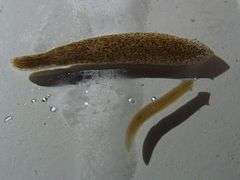Dugesiidae
Dugesiidae is a family of freshwater planarians distributed worldwide (except Antarctica). The type genus is Dugesia Girard, 1850.[3]
| Dugesiidae | |
|---|---|
 | |
| Girardia sp. (top) and Dugesia sp. (down) | |
| Scientific classification | |
| Kingdom: | |
| Phylum: | |
| Class: | |
| Order: | |
| Suborder: | |
| Superfamily: | |
| Family: | Dugesiidae Ball, 1974 |
| Genera[1][2] | |
Description
All species of Dugesiidae live in freshwater environments and have a dorsoventrally flattened body. The head usually has a somewhat triangular shape and have two eyes (except for some subterranean eyeless species). The main differences between Dugesiidae and other freshwater planarians are related to the anatomy of the eyes and the copulatory apparatus. The eye cup in Dugesiidae is composed of several retinal cells, while in other freshwater planarians they are composed of a single cell.[4]
All freshwater planarians have an accessory organ called copulatory bursa or bursa copulatrix, which is connected to the genital atrium by a canal. In Dugesiidae, the oviducts, which conduct the eggs from the ovaries to the genital atrium, open into the bursal canal, while in other freshwater planarians they open directy into the genital atrium.[5]
Phylogeny
According to molecular analyses, Dugesiidae is the sister group of land planarians.[6][4]
Phylogenetic supertree including all major triclad groups after Sluys et al., 2009:[1]
| Tricladida |
| ||||||||||||||||||||||||||||||||||||
Phylogenetic subtree including five dugesiid genera after Álvarez-Presas et al., 2008:[4]
| Dugesiidae |
| ||||||||||||||||||||||||
References
- Sluys, R.; Kawakatsu, M.; Riutort, M.; Baguñà, J. (2009). "A new higher classification of planarian flatworms (Platyhelminthes, Tricladida)". Journal of Natural History. 43 (29–30): 1763–1777. doi:10.1080/00222930902741669.
- Sluys, R.; Solà, E.; Gritzalis, K.; Vila-Farré, M.; Mateos, E.; Riutort, M. (2013). "Integrative delineation of species of Mediterranean freshwater planarians (Platyhelminthes: Tricladida: Dugesiidae)". Zoological Journal of the Linnean Society. 169 (3): 523. doi:10.1111/zoj.12077.
- Ball, I. R.: A contribution to the phylogeny and biogeography of the freshwater triclads (Platyhelminthes: Turbellaria). Biology of the Turbellaria (Edited by: Riser NW and Morse MP). New York: McGraw-Hill New York 1974, 339-401.
- Álvarez-Presas, M.; Baguñà, J.; Riutort, M. (2008). "Molecular phylogeny of land and freshwater planarians (Tricladida, Platyhelminthes): From freshwater to land and back". Molecular Phylogenetics and Evolution. 47 (2): 555–568. doi:10.1016/j.ympev.2008.01.032. PMID 18359250.
- Vries, Elizabeth J.; Sluys, Ronald (1991). "Phylogenetic relationships of the genus Dugesia (Platyhelminthes, Tricladida, Paludicola)". Journal of Zoology. 223 (1): 103–116. doi:10.1111/j.1469-7998.1991.tb04752.x. ISSN 0952-8369.
- Carranza, S.; Littlewood, D. T.; Clough, K. A.; Ruiz-Trillo, I.; Baguñà, J.; Riutort, M. (1998). "A robust molecular phylogeny of the Tricladida (Platyhelminthes: Seriata) with a discussion on morphological synapomorphies". Proceedings of the Royal Society B: Biological Sciences. 265 (1396): 631–640. doi:10.1098/rspb.1998.0341. PMC 1689013. PMID 9881470.
| Wikispecies has information related to Dugesiidae |